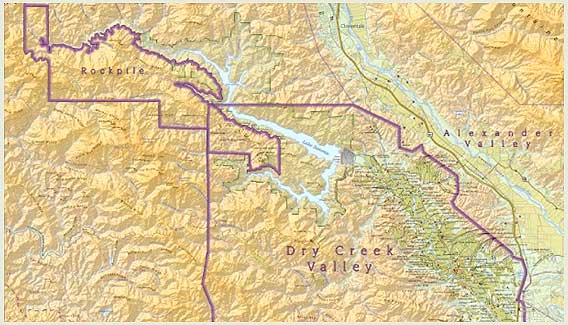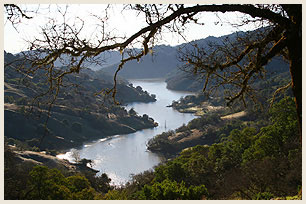ROCKPILE VITICULTURE FACTS
"...One of the finest Zinfandel sites in Northern California..." ~ Robert Parker
Appreciation for the diversity of grape growing regions in California and the need for classification of these areas is something that has developed relatively recently. After years of consideration, the United States government established a system of American Viticultural Areas, AVA’s, in 1983 to give individual regions the recognition they deserve. Current regulations impose the following requirements on an AVA:
- Evidence that the name of the new proposed AVA is locally or nationally known as referring to the area.
- Historical or current evidence that boundaries are evident.
- Evidence that growing conditions such as climate, soil, elevation, and physical features are distinctive.

©2007 TheMapStore. To explore an interactive map, visit
The Map Store
While Rockpile is one of the newest in California, receiving AVA status April 29th, 2002, the area has been referred to as Rockpile since the 1850’s. Located in Northern Sonoma County, at the northwest corner of Dry Creek Valley, the Rockpile AVA encompasses nearly 15,000 acres, of which less than 160 are planted to vineyard. This makes Rockpile one of the smallest AVAs in the United States in terms of acreage planted. Approximately 2,500 of the acres of the Rockpile AVA overlap the Dry Creek Valley viticultural area to the Southeast. Vineyards range in elevation from 800' to nearly 2100'.
There are many geographic and geologic features that separate Rockpile from its neighboring appellations. The combination of an elevation requirement, extreme terrain, and a unique climate make the vineyards and resulting wines unlike anything from Sonoma County, California—or the world for that matter.
Geography
The predominant geographic highlight is that all vineyards must be at 800' elevation and above to qualify. This elevation requirement also serves as the appellation boundary to the East as well as the North. Though it falls into the geographic category, it also greatly affects the geology and climate. There are certain aspects that are true of all elevation delineated AVA’s; poor soils, steep slopes, little water retention and great sun and wind exposures. With Rockpile these aspects are exaggerated due to the lack of fog.

Lake Sonoma quells the normal coastal fog pattern,
increasing sun exposure and decreasing moisture
on the vines.
The 800' elevation mark was chosen with specific reasoning, during the ripening season, above 800' you have virtually no fog. This is especially unique given the proximity to the Pacific Ocean. At most points in the appellation, the Pacific is less than 16 miles to the west. The closer proximity should lead to more fog in the area, but the presence of Lake Sonoma limits the exposure to the Rockpile AVA. Lake Sonoma is a relatively deep lake, over 200 ft deep in many areas. With nearly 2,500 surface acres, this large body of water holds its temperature extremely well. This creates an inversion layer, sucking the fog down to the surface of the lake, limiting the fog exposure to the AVA. The lack of fog increases the amount of sun exposure, but decreases the amount of moisture available to the vines. The lack of moisture leads to smaller berries, loose bunches, little to no bunch rot or botrytis, and over all higher quality fruit.
It goes without saying that Rockpile vineyards should have great sun exposure The direction a vineyard faces can influence the flavors, aromas, and overall complexion of the wine. The Rockpile ridgeline runs northwest toward the Pacific Ocean, giving much of the vineyards either a southwestern or northeastern slope. Vineyards with a southwestern exposure have the benefit of full sun during the heat of the day, often leading to bold and powerful wines. Vineyards with a northeastern exposure present an indirect angle to the sun during the afternoon, regularly leading to longer hang times and more complex flavors. What makes this area especially unique is the variety of exposures. While northeast and southwest are predominant, there is every conceivable variation, yielding incredible complex and unique wines.
Geology
The soils in the Rockpile AVA are very different to that of its neighboring viticultural areas. The primary differences are; the extreme shallowness of the soils, the relative absence of silt or sand, higher oxidized iron properties, and the clay subsoil.
The steep slope of the Rockpile area had drained much of the topsoil to the valley floor millennia ago. The topsoil that remains is generally loam to clay loam with a red brown color due to the higher oxidation. It is only 12 to 24 inches deep in the best of viticultural locations. There are areas of small rock and gravel mixed in the topsoil, with many outcroppings of larger rock. Given the extreme geography; the topsoil depth, amounts of clay and rock, and organic material varies greatly throughout the AVA. These geologic conditions, coupled with the topography, contribute to well-drained vineyard conditions. The overall poor quality of soil leads to stressed vines with low yields and intense fruit.
Climate
Over 95% of the vineyards in the Rockpile AVA are over 1,000' in elevation. This higher elevation, combined with the close proximity to the Pacific Ocean, creates very unique climatic influences. The moderate temperatures, high winds, and lack of fog present an optimal growing environment for fruit of the highest quality. As was discussed in the geography section, lack of fog is essential to the high quality of fruit, but the other climatic factors are as important if not more.
One of the most under-appreciated characteristics of the Rockpile AVA is the wind. Being at a higher elevation, Rockpile receives the full force of the coastal breezes that typically sweep over the neighboring valleys. It is not only the velocity of the wind, but the high percentage of the day in which it blows. It is a rare occurrence that there is any hour of the day without gusts of 3-5 mph; more commonly, the onshore flow feeds the area with sustained gusts of 10-15 mph. The winds stress the vines by further drying out what little water retention there may be in the soil and they insure that there will be little or no rot in Rockpile fruit. This has the added bonus of limiting the need for herbicide and or pesticide use in the vineyards.
The temperature in Rockpile is extremely moderate. The average daily high temperatures are lower than that of the neighboring valleys while the average lows are higher. At first glance it may seem strange, but this is prototypical coastal influence. Rockpile, at its furthest point, is only 16 miles from the Pacific. The elevation only compounds the maritime effect. This creates an ideal growing condition for the vineyards. There is less temperature fluctuation, allowing the vines long steady growth. The mild highs and lows prevent shock to the vine which would inhibit photosynthesis. The moderate temperatures are also a factor in the uniformity of ripening that is unique to Rockpile, especially as it relates to Zinfandel. Extreme highs often cause dehydration, or raisining, of the fruit, leading to uneven ripening and a lower quality of fruit.
The average annual rainfall for the Rockpile region is 50–73 inches.